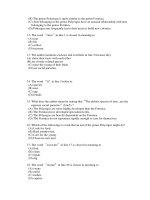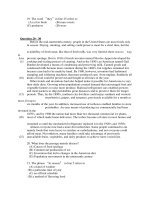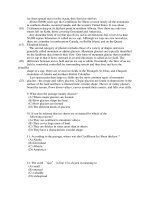kí năng đọc hiểu trong toeic 4 pps
Bạn đang xem bản rút gọn của tài liệu. Xem và tải ngay bản đầy đủ của tài liệu tại đây (64.67 KB, 6 trang )
Questions 38-50
What we today call American folk art was, indeed, art of, by, and for ordinary,
everyday “folks” who, with increasing prosperity and leisure, created a market for art
of all kinds, and especially for portraits. Citizens of prosperous, essentially
Line middle-class republics ― whether ancient Romans, seventeenth-century Dutch
(5) burghers, or nineteenth-century Americans ― have always shown a marked taste for
portraiture. Starting in the late eighteenth century, the United States contained
increasing numbers of such people, and of the artists who could meet their demands.
The earliest American folk art portraits come, not surprisingly, from New
England ― especially Connecticut and Massachusetts ― for this was a
wealthy and
(10) populous region and the center of a strong craft tradition. Within a few decades after
the signing of the Declaration of Independence in 1776, the population was pushing
westward, and portrait painters could be found at work in western New York, Ohio,
Kentucky, Illinois, and Missouri. Midway through its first century as a nation, the
United States's population had increased roughly five times, and eleven new states had
(15) been added to the original thirteen. During these years the demand for portraits grew
and grew eventually to be satisfied by the camera. In 1839 the daguerreotype was
introduced to America, ushering in the age of photography, and within a generation the
new invention put an end to the popularity of painted portraits. Once again an
original
portrait became a luxury, commissioned by the wealthy and executed by the
(20) professional.
But in the heyday of portrait painting ― from the late eighteenth century until the
1850's ― anyone with a modicum of artistic ability could become a limner, as such a
portraitist was called. Local craftspeople ― sign, coach, and house painters ― began to
paint portraits as a profitable sideline ; sometimes a talented man or woman who began
(25) by sketching family members gained a local reputation and was besieged with requests
for portraits ; artists found it worth their while to pack their paints, canvases, and
brushes and to travel the countryside, often combining house decorating with portrait
painting.
38. In lines 4-5 the author mentions seventeenth-century Dutch burghers as an
example of a group that
(A) consisted mainly of self-taught artists
(B) appreciated portraits
(C) influenced American folk art
(D) had little time for the arts
39. The word “marked”in line 5 is closest in meaning to
(A) pronounced
(B) fortunate
(C) understandable
(D) mysterious
40. According to the passage, where were many of the first American
folk art portraits painted?
(A) In western New York
(B) In Illinois and Missouri
(C) In Connecticut and Massachusetts
(D) In Ohio
41. The word “this”in line 9 refer to
(A) a strong craft tradition
(B) American folk art
(C) New England
(D) western New York
42. How much did the population of the United States increase in the first fifty years
following independence?
(A) It became three times larger.
(B) It became five times larger.
(C) It became eleven times larger.
(D) It became thirteen times larger.
43. The phrase “ushering in”in line 17 is closest in meaning to
(A) beginning (B) demanding
(C) publishing (D) increasing
44. The relationship between the daguerreotype(line 16)and the painted portrait is
similar to the relationship between the automobile and the
(A) highway (B) driver (C) horse-drawn carriage (D) engine
45. According to the passage, which of the following contributed to a decline in the
demand
for painted portrait?
(A) The lack of a strong craft tradition
(B) The westward migration of many painters
(C) The growing preference for landscape paintings
(D) The invention of the camera
46. The word “executed” in line 19 is closest in meaning to
(A) sold (B) requested
(C) admired (D) created
47. The author implies that most limners (line 22)
(A) received instruction from traveling teachers
(B) were women
(C) were from wealthy families
(D) had no formal art training
48. The word “sketching” in line 25 is closest in meaning to
(A) drawing (B) hiring
(C) helping (D) discussing
49. Where in the passage does the author provide a definition?
(A) Lines 3-6 (B) Lines 8-10
(C) Lines 13-15 (D) Lines 21-23
50. The phrase “worth their while”in line 26 is closest in meaning to
(A) essential (B) educational
(C) profitable (D) pleasurable
Test 3
Questions 1-10
Around the year 1500, hunting people occupied the entire northern third of North
America. They lived well from the animals with whom they shared these lands. Hunters
of sea mammals had colonized the Arctic coasts of Canada and Greenland between
Line four and five thousand years before. Land-hunting people had lived throughout much
(5) of the northern interior for at least 12,000 years.
Northern North America is part of a larger circumpolar ecological domain that
continues across the narrow Bering Strait into Siberia and northern Europe. The overall
circumpolar environment in the 1500's was not very different from the environment of
the present. This vast landmass had a continental climate and was dominated by cold
(10) arctic air throughout a long winter and spring season. Summer temperature ranged
from near freezing to the mid-20's Celsius, while winter temperature were often as
low as 40 degrees below zero Celsius.
Geographers divide the overall circumpolar domain into two zones, the Arctic and,
below it, the Subarctic. They refer to the landforms of these areas as tundra and taiga,
(15) respectively.
Temperatures in the northern lands were below freezing for eight or nine months of
the year. Subsurface soil in the Arctic's tundra remained permanently frozen. Even
when summer temperatures were above freezing and the top inches of earth became
saturated with water, the soil below remained frozen into a permafrost, as hard as rock.
(20) When water flowed upon the surface of permanently frozen tundra, it made overland
travel extremely difficult. Summer travel in the boggy lands, or muskeg country, of the
Subarctic's taiga was also slow and arduous. Tracking animals was more difficult than
it was during the winter when the swampy ground was frozen solid and covered with
snow. In both tundra and taiga, hordes of mosquitoes and biting flies bred in the
(25) standing pools of water. Clothing lost its thermal efficiency when it became damp.
Northern people looked forward to the turn of the season to bring the easier traveling
conditions associated with cold weather. In the Arctic, they could haul food and
supplies by dogsled while in the Subarctic, people could travel quickly and efficiently
by snowshoes and toboggan.
1. What does the passage mainly discuss?
(A) The hunting people of North America
(B) The circumpolar environment of the sixteenth century
(C) Animals that inhabit the Arctic coast
(D) The geography of Canada and Greenland
2. The word “domain”in line 6 is closest in meaning to
(A) temperature
(B) period
(C) region
(D) process
3. Which of the following terms is used to describe the landforms
of the Arctic region?
(A) Subarctic
(B) Taiga
(C) Tundra
(D) Muskeg
4. For how many months of the year were temperatures below freezing
in the circumpolar region?
(A) 4-5 months (B) 6 months
(C) 8-9 months (D) 12 months
5. The word “saturated”in line 19 is closest in meaning to
(A) enriched (B) dissolved
(C) removed (D) soaked
6. The word “arduous”in line 22 is closest in meaning to
(A) humid (B) difficult
(C) indirect (D) unnecessary
7. The word “standing”in line 25 is closest in meaning to
(A) not flowing (B) very deep
(C) numerous (D) contaminated
8. All of the following are mentioned as having made travel in the summer
difficult EXCEPT
(A) insects (B) wet clothing
(C) swampy lands (D) lack of supplies
9. The subsurface soil in the Arctic's tundra is most comparable to which
of the following?
(A) Cement (B) A bog
(C) A pond (D) Sand
10. Where in the passage does the author mention a means by which
people traveled in the northern lands?
(A) Lines 2-4
(B) Lines 6-7
(C) Lines 20-21
(D) Lines 27-29
Question 11-20
Social parasitism involves one species relying on another to raise its young. Among
vertebrates, the best known social parasites are such birds as cuckoos and cowbirds; the
female lays egg in a nest belonging to another species and leaves it for the host to
Line rear.
(5) The dulotic species of ants, however, are the supreme social parasites. Consider, for
example, the unusual behavior of ants belonging to the genus Polyergus. All species of
this ant have lost the ability to care for themselves. The workers do not forage for food,
feed their brood or queen, or even clean their own nest. To compensate for these
deficits, Polyergus has become specialized at obtaining workers from the related genus
(10) Formica to do these chores.
In a raid, several thousand Polyergus workers will travel up to 500 feet in search of
a Formica nest, penetrate it, drive off the queen and her workers, capture the pupal
brood, and transport it back to their nest. The captured brood is then reared by the
resident Formica workers until the developing pupae emerge to add to the Formica
(15) population, which maintains the mixed-species nest. The Formica workers forage for
food and give it to colony members of both species. They also remove wastes and
excavate new chambers as the population increases.
The true extent of the Polyergus ants' dependence on the Formica becomes apparent
when the worker population grows too large for existing nest. Formica scouts locate
(20) a new nesting site, return to the mixed-species colony, and recruit additional Formica
nest mates. During a period that may last seven days, the Formica workers carry to the
new nest all the Polyergus eggs, larvae, and pupae, every Polyergus adult, and even the
Polyergus queen.
Of the approximately 8,000 species of ants in the world, all 5 species of Polyergus
(25) and some 200 species in other genera have evolved some degree of parasitic
relationship with other ants.
11. Which of the following statements best represents the main idea of the passage?
(A) Ants belonging to the genus Formica are incapable of performing certain tasks.
(B) The genus Polyergus is quite similar to the genus Formica.
(C) Ants belonging to the genus Polyergus have an unusual relationship with ants
belonging to the genus Formica.
(D) Poltergus ants frequently leave their nests to build new colonies.
12. The word “raise”in line 1 is closest in meaning to
(A) rear
(B) lift
(C) collect
(D) increase
13. The author mentions cuckoos and cowbirds in line 2 because they
(A) share their nests with each other
(B) are closely related species
(C) raise the young of their birds
(D) are social parasites
14. The word “it”in line 3 refers to
(A) species
(B) nest
(C) egg
(D) female
15. What does the author mean by stating that“The dulotic species of ants are the
supreme social parasites”(line5) ?
(A) The Polyergus are more highly developed than the Formica.
(B) The Formica have developed specialized roles.
(C) The Polyergus are heavily dependent on the Formica.
(D) The Formica do not reproduce rapidly enough to care for themselves.
16. Which of the following is a task that an ant of the genus Polyergus might do?
(A) Look for food.
(B) Raid another nest.
(C) Care for the young.
(D) Clean its own nest.
17. The word “excavate”in line 17 is closest in meaning to
(A) find
(B) clean
(C) repair
(D) dig
18. The word “recruit”in line 20 is closest in meaning to
(A) create
(B) enlist
(C) endure
(D) capture









